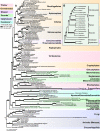Broadly sampled multigene trees of eukaryotes
- PMID: 18205932
- PMCID: PMC2249577
- DOI: 10.1186/1471-2148-8-14
Broadly sampled multigene trees of eukaryotes
Abstract
Background: Our understanding of the eukaryotic tree of life and the tremendous diversity of microbial eukaryotes is in flux as additional genes and diverse taxa are sampled for molecular analyses. Despite instability in many analyses, there is an increasing trend to classify eukaryotic diversity into six major supergroups: the 'Amoebozoa', 'Chromalveolata', 'Excavata', 'Opisthokonta', 'Plantae', and 'Rhizaria'. Previous molecular analyses have often suffered from either a broad taxon sampling using only single-gene data or have used multigene data with a limited sample of taxa. This study has two major aims: (1) to place taxa represented by 72 sequences, 61 of which have not been characterized previously, onto a well-sampled multigene genealogy, and (2) to evaluate the support for the six putative supergroups using two taxon-rich data sets and a variety of phylogenetic approaches.
Results: The inferred trees reveal strong support for many clades that also have defining ultrastructural or molecular characters. In contrast, we find limited to no support for most of the putative supergroups as only the 'Opisthokonta' receive strong support in our analyses. The supergroup 'Amoebozoa' has only moderate support, whereas the 'Chromalveolata', 'Excavata', 'Plantae', and 'Rhizaria' receive very limited or no support.
Conclusion: Our analytical approach substantiates the power of increased taxon sampling in placing diverse eukaryotic lineages within well-supported clades. At the same time, this study indicates that the six supergroup hypothesis of higher-level eukaryotic classification is likely premature. The use of a taxon-rich data set with 105 lineages, which still includes only a small fraction of the diversity of microbial eukaryotes, fails to resolve deeper phylogenetic relationships and reveals no support for four of the six proposed supergroups. Our analyses provide a point of departure for future taxon- and gene-rich analyses of the eukaryotic tree of life, which will be critical for resolving their phylogenetic interrelationships.
Figures



References
-
- Melkonian M, Andersen RA, Schnepf E. The Cytoskeleton of Flagellate Protists. New York , Springer-Verlag; 1991.
-
- Wetherbee R, Andersen RA, Pickett-Heaps J. Protistan Cell Surfaces. New York , Springer-Verlag; 1994.
-
- Patterson DJ. In: An Illustrated Guide to the Protozoa. 2nd edition. Lee JJ, editor. Lawrence, Kansas , Society of Protozoologists; 2002. Changing views of protistan systematics: the taxonomy of protozoa - an overview.
Publication types
MeSH terms
Substances
LinkOut - more resources
Full Text Sources
Molecular Biology Databases

